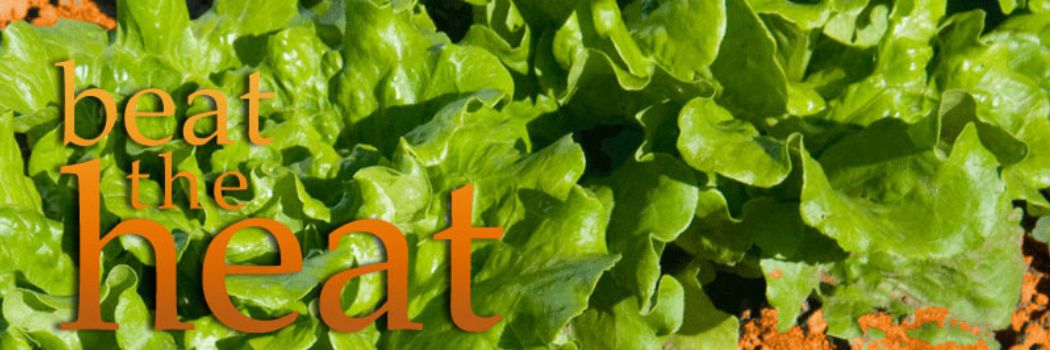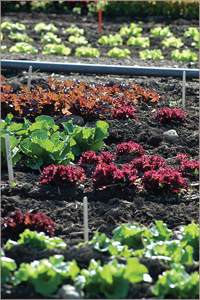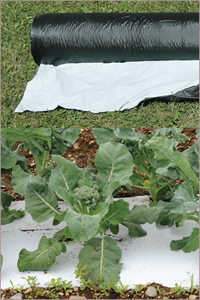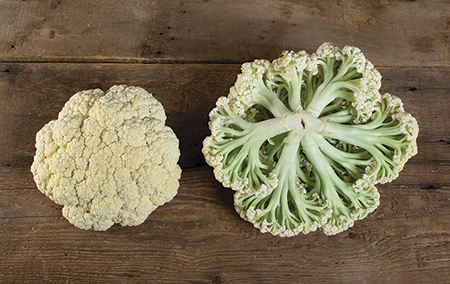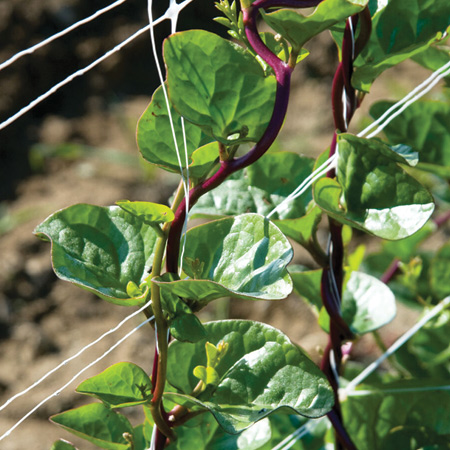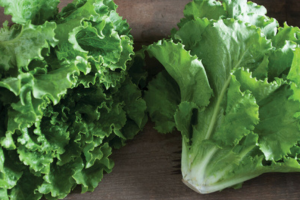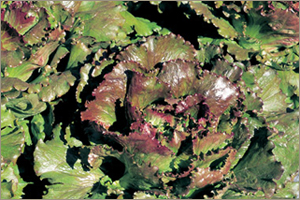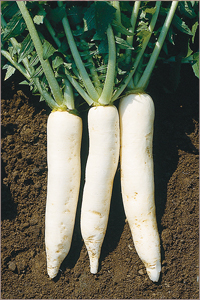- Heat & Drought: How Flower Farmers Are Adapting to Changing & Challenging Climatic Conditions
- Beat the Heat, Part 1: Cultural Best Practices to Prevent Heat Stress in Vegetables
- Beat the Heat, Part 2: Getting Your Cool-Weather Crops Through Summer's Heat
- Shade Cloth | Comparison Chart (PDF)
- Video: Beat the Heat: Lettuce & Greens for Southern Growers | Johnny's Webinar Series
- Video: Flower Growing in Southern States | Johnny's Webinar Series
- Video: Climate Adaptation for Vegetable & Flower Farmers | Johnny's Webinar Series
- Webinar Slide Deck | Flower Growing in Southern States | PDF
- Webinar Slide Deck | Climate Adaptation for Vegetable & Flower Farmers | 36-pp PDF
- Cooling & Storing Chart for Freshly-Harvested Summer Produce
- Webinar Slide Deck | Climate Adaptation in Action | PDF
- Webinar Slide Deck | Lettuce & Greens for Southern Growers | PDF
Part 2 • Getting Cool-Loving Crops through Summer's Heat
Beat the Heat
- Part 1: Cultural Practices to Prevent Heat Stress in Vegetable Crops
- Part 2: Getting Cool-Loving Crops Through Summer's Heat
Heat tolerance varies, by both crop & variety within crop
Just as human productivity can wane at the height of summer, so, too, can that of many vegetable crops. Also like us, vegetables vary in their sensitivity to heat and humidity, and in the stage of growth at which heat can be most damaging. For some, the heat-sensitive stage is seed germination; for others, it's flower bud development, fruit set, or some other period. Understanding these stages is important to plant breeders who want to develop heat-tolerant varieties in response to warming summer temperatures. Growers can apply this knowledge in planning their crop production cycles.
Before seeding, growers can refer to the germination guides we provide for each crop, to determine whether the soil is cool enough for optimal germination. Surprisingly, many of the vegetables we think of as cool-weather crops will germinate at very warm temperatures: Brassicas in general germinate very well in a very warm greenhouse, for instance, so shade cloth is not generally needed. Cabbage and cauliflower will germinate at 100°F (37.8°C), carrots and onions at 95°F (35°C), turnips at 105°F (40.6°C). But importantly, most varieties of these crops will not thrive if temperatures remain that high, because the plants must go through other growth stages that are more sensitive to heat.
Varieties of a single crop, too, vary in heat tolerance relative to one another. In this article we want to help growers plan for warmer periods by covering the rudiments of getting cool-weather-loving crops through the summer heat, with emphasis on varieties that outperform their peers in warm-weather trials.
Recommendations for Cool-Weather Crops
Look for the symbol—only varieties that pass with flying colors receive Johnny's Heat-Tolerant symbol.
Each year Johnny's conducts onsite and offsite trials in a range of locations to identify heat-tolerant, "cool-weather" varieties. We also consult with suppliers for data in even hotter areas. Each crop has specific heat-tolerance criteria on which it is evaluated. Flavor as well as performance and productivity are critical. Trials are timed so they coincide with the stressors of summer sun, heat, humidity, and long days. After trialing, we use the results to make our yearly selections and recommendations.
Broccoli
Before transplanting, apply White-on-Black Mulch, white-side-up, to help your broccoli crop safely shift between the vegetative and flowering stages (as well as to repress weeds, conserve moisture, and discourage pests and pathogens).
- The critical period for heat sensitivity in broccoli lasts just 10 days, during which time the growing point of the plant shifts from vegetative growth to flower bud initiation. This shift—not externally visible—occurs 10 days before the appearance of a tiny crown in the center of the plant, or about 3–4 weeks after plants are set out. Temperatures above 95°F (35°C) for more than 4 days during that critical period result in uneven, poorly shaped heads. A grower can use this information to choose which broccoli varieties to grow during which time slots, to maximize quality and yield.
- Our heat-tolerant varieties include 'Imperial', which is the best, and 'Green Magic', also a superior performer. Varieties that fare well in moderate heat include 'Gypsy'.
- In periods of extreme heat and/or humidity, however, such as those experienced in the Southeast, Deep South, and Florida, none perform well unless transplanted after the hottest part of summer has passed.
- Browse our Heat-Tolerant Broccoli Varieties.
- For suggestions on timing your broccoli plantings for warmer conditions, refer to our Broccoli Planting Program.
- For additional tips on timing, temperature, fertility, and watering of broccoli and other brassica crops, see our article on Success with Brassicas.
Brussels Sprouts, Cabbage & Chinese Cabbage
- All varieties of Brussels sprouts, cabbage, and Chinese cabbage perform reasonably well in areas with moderate summer heat.
- In areas of extreme heat and/or humidity, however, such as the US Southeast, Deep South, and Florida, these brassica crops will perform well only if transplanted after the hottest part of summer has passed.
Cauliflower
This variety derives from Asia, where green-stemmed, loose-curd cauliflower is popular and commonly grown in hot, humid areas.
- Beyond germination stage, cauliflower detests hot weather.
- In areas with moderate summer heat, white varieties that do reasonably well include 'Snow Crown' and 'Amazing', For color, choose 'Cheddar', 'Graffiti', and 'Vitaverde'.
- In extreme heat and/or humidity such as the Southeast, Deep South, and Florida, however, none of these perform well unless transplanted after summer's heat peak is passed.
- There is a type of cauliflower that derives from Asia, where it is commonly grown in hot, humid areas. 'Song TJS-65' is a sweet, early variety in this class. From the top it resembles a traditional white cauliflower but with looser, slightly smaller, easy-to-prep curds, and some refer to this type as "loose-curd cauliflower." On turning it over, its stems are pale green rather than white, so some others call this type "green-stemmed" cauliflower. The curds may develop a slight tinge of orange, but this is normal and does not diminish their eating quality.
- For suggestions on timing your cauliflower plantings for warmer conditions, refer to our Cauliflower Planting Program.
- For additional tips on timing, temperature, fertility, and watering of cauliflower and other heading brassica crops, see our article on Success with Brassicas.
Greens
We offer a diverse selection of greens, with some measure of heat tolerance, that will perform quite nicely, provided the grower adheres to good cultural practices as well as the recommended post-harvest cooling methods and storage guidelines.
Here are some more specific recommendations for success.
Try this heat-loving spinach substitute.
- Mustard greens that perform well include the uniquely mild-flavored 'Mizuna' and the popular 'Red Giant' and 'Red Splendor', all of Japanese origin. 'Green Wave' is the slowest-to-bolt choice.
- For a komatsuna variety with good heat tolerance, plant 'Carlton'.
- 'Shungiku', an edible species of chrysanthemum with finely serrate, exquisitely aromatic leaves, is another heat-tolerant green of Asian origin.
- Pac chois likewise prefer cool weather, but will perform relatively well in warm weather. Those that perform better in the heat than their peers include 'Win-Win Choi', 'Joi Choi', 'Mei Qing Choi', and 'Black Summer'. Compare days-to-maturity, color, size, and spacing with our Pac Choi Comparison Chart.
- Specialty greens perform well in the heat of the summer, except in regions with extreme heat. 'Red Leaf Vegetable Amaranth', a favorite Caribbean specialty green, is tough and resistant to both heat and some measure of drought. Heat-tolerant substitutes for spinach include 'Red Malabar Spinach', which is a true heat-lover.
- Browse all our Heat-Tolerant Greens.
Spinach
- During warmer seasons irrigation is a must for proper spinach germination, to keep soil temperatures cool. The benefits of irrigation described in Part 1 strongly apply to this crop.
- Spinach really likes cooler weather to germinate and grow, though slower-growing varieties can be chosen for late-spring and summer sowing. We recommend 'Seaside' and 'Lizard' for summer production. 'Space' is another option for this slot. 'Flamingo Improved' can also be used if an arrowhead leaf shape is desired, as this is one of the slower-bolting Asian types. (Please note that although one of the slower-bolting of these types, it is still quick to bolt!)
- For details on which spinach varieties to plant in sequence, see our Spinach Planting Program.
- Spinach should always be harvested promptly, before it begins to bolt, or stems will become stringy and flavors will be off.
Lettuce
- All the basic cultural practices described in Part 1, including irrigation, shade cloth, and seeding in cooler locations, should be used with lettuce as well.
- Whereas most lettuce varieties develop a bitter flavor when summer arrives, the Summer Crisps—also known as French Crisp or Batavia—keep their juicy sweetness. 'Fusion' is one of our best summer performers. 'Muir', technically a Batavian type, is also very heat-tolerant. Other Summer Crisps include 'Cherokee' and 'Magenta'.
- Of the other full-size head lettuces, we offer a number that have earned our Heat-tolerant Symbol by performing better than others in the heat: 'Tropicana', 'Panisse', 'Salvius', 'Adriana', and 'Skyphos'.
- For information on which varieties to plant in sequence, refer to our Head Lettuce Planting Program.
- For additional specs on bolt tolerance, tipburn tolerance, and heat tolerance, see our Full-Size Leaf Lettuce Comparison Chart.
- View all our Heat-Tolerant Lettuce Varieties.
Carrots
- Carrots are grown year-round, but summer heat causes increased bitterness and decreased sweetness. 'Romance' is our best variety for the heat of summer.
- When it's hot and dry, you can also grow shorter, smaller carrot types that mature relatively quickly, such as the Parisian market variety 'Atlas'.
- Growing carrots in the shadier, cooler part of the farm is critical for bringing them successfully through the heat.
- Sufficiently irrigating carrots from seeding to harvest can help keep soil cool, and flavor better. Roots that are well irrigated will be milder and less bitter.
- To learn more, see our 4-part Guide to Successful Carrot Culture.
Radishes
This is a Japanese-style daikon radish suitable for mid and late-summer harvest.
- Along with holding good flavor, we evaluate radishes for heat tolerance by how crisp they stay and how soon they become pithy in warmer weather.
- For Round Red Radishes, we additionally evaluate how well they retain an attractive, uniformly round radish shape. 'Rover' and 'Sora' are our best heat-tolerant conventional and organic radishes, respectively. Most small round radishes do not do well in extreme heat.
- For Specialty Types and Daikons, these can work well in more northerly latitudes: 'Shunkyo Semi-Long', 'Nero Tondo', 'KN-Bravo', 'Alpine', and 'Summer Cross No. 3'. Refer to our Specialty & Daikon Radish Planting Program for additional details.
- Note that the flavor of all radishes will tend to be hotter and harsher when grown in hot weather than when grown in cool weather. This is especially true of the specialty and daikon types.
- Browse our Heat-Tolerant Radishes.
Choosing varieties for heat tolerance—One of a set of variables in the summer-success equation
Even the most heat-tolerant, cool-weather varieties have their upper limits. In the Deep South none of the crops mentioned in this article are grown at the height of summer, with the exception of summer carrots, perhaps. And lettuce will always perform better in cooler conditions. Nevertheless, people want to enjoy fresh salads and slaws all summer long, so a selection of varieties that perform well through the stressful summer growing conditions must always be available. The varieties we carry and recommend here at Johnny's, while still affected by intense summer conditions, will outperform others.
Succession planting also plays a fundamental role in the equation for summer success, including the practice of sowing Summer-Plant for Fall-Harvest Varieties. While succession planting is often regarded as a season-extension strategy in principle, in this case it relates to working in sync with seasonal temperature cycles, leveraging higher germination temperature ranges of certain crops and planning the time of harvest to occur in cooler temps. Brassicas, carrots, and turnips are prime candidates for planting in the heat of summer. To learn more, refer to the articles and calculator provided in our Succession Planting Overview.
No matter where you grow, putting a plan in place before the arrival of peak hot, humid weather will help minimize the detrimental effects of heat on your success. By choosing varieties known to be heat-tolerant, timing your plantings accordingly, following Best Hot-Weather Cultural Practices, and Cooling & Storing Your Summer-Harvested Crops correctly—as well as tracking what works best under which conditions—you can maximize the quality of your cool-weather crops during warm and hot weather.


